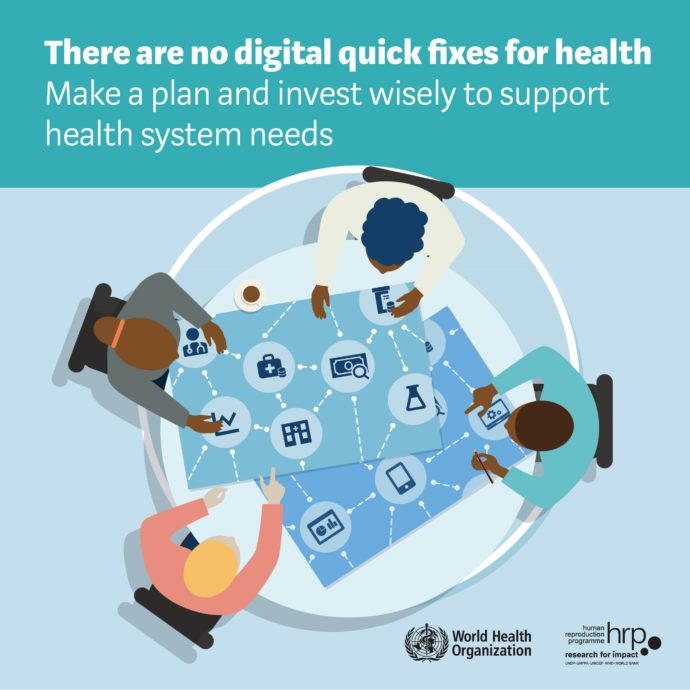Investment in digital health needs careful planning: new WHO guide explains how to do it well
By World Health Organization
Oct 15, 2020

Graphic: World Health Organization.
This post first appeared on the World Health Organization website. The BID Initiative and PATH contributed to the writing of the Digital Implementation Investment Guide.
With the right approach and effective investment, digital health interventions can be successful long-term solutions that help to improve the health and well-being of the people they were designed to reach. A new guide has been launched by World Health Organization (WHO) to help ensure that digital health investments are effective, sustainable, and equitable – and that they are implemented in a coordinated way and appropriate for the local context.
The Digital Implementation Investment Guide: Integrating Digital Interventions into Health Systems, also known as the DIIG, has been published by the WHO and HRP in collaboration with PATH, UNICEF, and UNFPA. This guidance will be particularly useful for donors and ministries of health who make decisions on digital investments for health – in government, in technical bodies, and in national health and/or digital systems.
Ian Askew, Director of the WHO Department of Sexual and Reproductive Health and Research and HRP comments, “No matter where you live, there are unique health needs which digital technologies can help to meet. But these technologies can only be effective if they recognize these unique needs, if they are appropriate to the context – and if they receive sustained and informed investment.”
How-to guide on digital health
The guide gives a step-by-step approach to planning, costing, and implementing digital health investments. Users learn from diverse experiences covering the past ten years, from institutions who have been deeply involved with planning and implementing digital health technologies with national governments. In using the guide, readers learn how to design, cost, and implement meaningful digital health systems through a well-defined plan that will facilitate further collaboration and investment.
Realizing the potential of digital health
Digital health tools have the potential to transform health services and help accomplish universal health coverage. With sustainable and robust governance structures in place. It can reform public health systems by improving its reach, impact, and efficiency.
Investing wisely and well
Wiser investment in digital health technologies is needed. However, in order to fully realize their potential, and to enhance the integral role that they can play within health systems, it is crucial that such investment is responsible and well-thought through.
Dr. Soumya Swaminathan, Chief Scientist at WHO remarks in the foreword to the guide that, “Investment must be carefully and thoughtfully coordinated for equitable access to meet the full spectrum of health needs leveraging mature digital public goods, and building on digital development and donor principles to maximize the benefits of digital investments.”
Responsible and informed investment in the right technologies, appropriate for the context and health system and for the existing digital architecture, is critical for ensuring their success.
Coordination of digital health
Good planning and governance on digital health or by investors, governments, and technical bodies is needed when working to integrate digital investments into health systems. Coordination of digital health systems is key for ensuring that digital investments are effective, promote equitable access to health, and address the health needs of the local context.
The DIIG aims to help all people involved with decision making related to digital health technologies to coordinate effectively and harmonize their efforts when investing in and integrating digital health technologies.
Mr. Bernardo Mariano, Director of the WHO Digital Health Department and Innovation, comments, “The DIIG is a tool that encourages strategic collaboration and governance. It helps decision-makers make ethical and evidence-based decisions, with sustainability and equity at their core, in coordination with people working across sectors.”
Principles at heart
The guide is underpinned by a set of nine principles for digital development to help stakeholders effectively and appropriately apply digital technologies in their health programmes.
Dr. Garrett Mehl, a scientist in the WHO Department of Sexual and Reproductive Health and Research comments, “If implemented in a strategically harmonized manner, leveraging the key principles and messages presented in the DIIG, these digital health systems are powerful tools that will help us achieve the ultimate goal of health and well-being for all.”
The DIIG is rooted in evidence and WHO guidance, and is part of a growing suite of digital health tools to help countries effectively put into place, scale-up, maintain, and evaluate the impact of digital health interventions. It complements the WHO guidance on digital health interventions, which examined the evidence for and issues to consider around implementing digital health.
